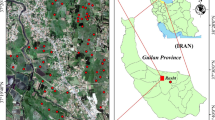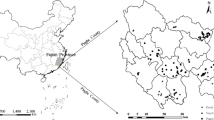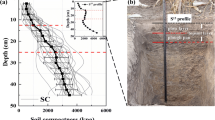Abstract
Yellow clayey paddy soil is a typical soil with low productivity in southern China. However, a systematic evaluation of soil quality, which is important for improving sustainable land use management and increasing crop yields, has not been carried out for yellow clayey paddy soils. This study adopted two indicator selection methods, Total Data Set (TDS) and Minimum Data Set (MDS), to evaluate soil quality of high (HPPS), medium (MPPS) and low (LPPS) productive yellow clayey paddy soils and aimed to identify the factors limiting the rice productivity. Twenty-six soil parameters including physical, chemical and microbiological properties including phospholipid fatty acid analysis, were determined. Most measured soil parameters showed significant differences (P ≤ 0.05) between the different productivity paddy soils. Best values were always observed for many soil properties in HPPS, indicating a better nutrient supply and microbiological activity. Those 15 variables having significant differences were selected for principal component analysis, and arbuscular mycorrhizal fungi (AMF), microbial biomass carbon (MBC), available silicon (ASi), available potassium (AK) and total nitrogen (TN) were retained in the refined MDS. After scoring and weighting the selected indicators, a soil quality index (SQI) was calculated using the Integrated Quality Index equation. Based on the TDS method, the mean SQI scores of HPPS, MPPS and LPPS were 0.79, 0.71 and 0.57, respectively. Similarly, HPPS, MPPS and LPPS showed average SQI scores of 0.82, 0.67 and 0.50, respectively, using the MDS method. A significant correlation was observed between SQI and rice yield considering both TDS and MDS methods. Although the TDS method is more accurate, the MDS method can adequately represent the TDS method (r 2 = 0.85). Low levels of AK and TN were considered as the major constraints limiting the rice productivity for LPPS. All soil samples collected were rich in available P, Zn and Si, but deficient in available K, which may be the major constraint for the studied regions.





Similar content being viewed by others
References
Alef K, Nannipieri P (1995) Methods in applied soil microbiology and biochemistry. Academic Press, London, pp 311–73
Andrews SA, Mitchell JP, Mancinelli R, Karlen DL, Hartz TK, Horwath WR, Pettygrove GS, Scow KM, Munk DS (2002) On-farm assessment of soil quality in California's central valley. Agron J 94:12–3
Andrews SS, Carroll CR (2001) Designing a soil quality assessment tool for sustainable agroecosystem management. Ecol Appl 11:573–585
Arshad MA, Martin S (2002) Identifying critical limits for soil quality indicators in agro-ecosystems. Agr Ecosyst Environ 88:153–160
Barrios E, Trejo MT (2003) Implications of local soil knowledge for integrated soil management in Latin America. Geoderma 111:217–31
Bastida F, Moreno JL, Hernández T, García C (2006) Microbiological degradation index of soils in a semiarid climate. Soil Biol Biochem 38:3463–3473
Bastida F, Zsolnay A, Hernández T, García C (2008) Past, present and future of soil quality indices: Abiological perspective. Geoderma 147:159–171
Beare MH, Bruce RR (1993) A comparison of methods for measuring water-stable aggregates: implications for determining environmental effects on soil structure. Geoderma 56:87–104
Bending GD, Turner MK, Rayns F, Marx MC, Wood M (2004) Microbial and biochemical soil quality indicators and their potential for differentiating areas under contrasting agricultural management regimes. Soil Biol Biochem 36:1785–1792
Bhardwaj AK, Jasrotiaa P, Hamiltona SK, Robertson GP (2011) Ecological management of intensively cropped agro-ecosystems improves soil quality with sustained productivity. Agr Ecosyst Environ 140:419–429
Blake GR, Hartge KH (1986) Bulk density. In: Klute A (ed) Methods of soil analysis: Part 1, 2nd edn. America Society of Agronomy, Madison, pp 363–375
Brady NC (1974) The nature and properties of soil, 8th edn. Macmillan, New York, p 639
Brejda JJ, Moorman TB, Karlen DL, Dao TH (2000) Identification of regional soil quality factors and indicators. Central and Southern High Plains. Soil Sci Soc Am J 64:2115–2124
Chaer GM, Myrold DD, Bottomley PJ (2009) A soil quality index based on the equilibrium between soil organic matter and biochemical properties of undisturbed coniferous forest soils of the Pacific Northwest. Soil Biol Biochem 41:822–830
Chilima J, Huang CY, Wu CF (2002) Microbial biomass carbon trends in black and red soils under single straw application: effect of straw placement, mineral N addition and tillage. Pedosphere 12:59–72
Doran JW, Parkin TB (1994) Defining and assessing soil quality. In: Doran JW (ed) Defining soil quality for a sustainable environment. Soil Science Society of America Special Publication, Madison, pp 3–21
Doran JW, Stamatiadis SI, Haberern J (2002) Soil health as an indicator of sustainable management. Agr Ecosyst Environ 88:107–110
Fernández-Ugalde O, Virto I, Bescansa P, Imaz MJ, Enrique A, Karlen DL (2009) No-tillage improvement of soil physical quality in calcareous, degradation-prone, semiarid soils. Soil Till Res 106:29–35
Garcia-Gil JC, Plaza C, Soler-Rovira P, Polo A (2000) Long-term effects of municipal solid waste compost application on soil enzyme activities and microbial biomass. Soil Biol Biochem 32:1907–1913
García-Ruiz R, Ochoa V, Viñegla B, Hinojosa MB, Peña-Santiago R, Liébanas G, Linares JC, Carreira JA (2009) Soil enzymes, nematode community and selected physico-chemical properties as soil quality indicators in organic and conventional olive oil farming: influence of seasonality and site features. Appl Soil Ecol 41:305–314
Gee GW, Bauder JW (1986) Particle-size analysis. In: Klute A (ed) Methods of soil analysis. Part 1. Physical and mineralogical methods. American Society of Agronomy, Madison, pp 383–411
Huang M, Jiang LG, Zou YB, Xu SH, Deng GF (2013) Changes in soil microbial properties with no-tillage in Chinese cropping systems. Biol Fertil Soils 49:373–377
Jakobsen I (1999) Transport of phosphorus and carbon in arbuscular mycorrhizas. In: Varma A (ed) Mycorrhiza: structure, function, molecular biology, 2nd edn. Springer, Heidelberg, pp 535–542
Kamprath EJ, Watson ME (1980) Conventional soil and tissue tests for assessing the phosphorus status of soil. In: Khasawneh FE (ed) The role of phosphorus in agriculture. Soil Science Society of America, Madison, WI, pp 443–469
Khan S, Hanjra MA, Mu JX (2009) Water management and crop production for food security in China: a review. Agr Water Manage 96:349–360
Kozdroj J, van Elsas JD (2001) Structural diversity of microorganisms in chemically perturbed soil assessed by molecular and cytochemical approaches. J Microbiol Meth 43:197–212
Krowntree KM, Fox RC (2008) Active learning for understanding land degradation: African catchment game and risk map. Geogr Res 46:39–50
Lal R (2004) Soil carbon sequestration to mitigate climate change. Geoderma 123:1–22
Lauber CL, Strickland MS, Bradford MA, Fierer N (2008) The influence of soil properties on the structure of bacterial and fungal communities across land-use types. Soil Biol Biochem 40:2407–2415
Li P, Zhang TL, Wang XX, Yu DS (2013) Development of biological soil quality indicator system for subtropical China. Soil Till Res 126:112–118
Li ZJ, Xu JM, Tang CX (2006) Application of 16S rDNA-PCR amplification and DGGE fingerprinting for detection of shift in microbial community diversity in Cu, Zn and Cd contaminated paddy soils. Chemosphere 62:1374–1380
Liang YC, Sun WC, Zhu YG, Christie P (2007) Mechanisms of silicon-mediated alleviation of abiotic stresses in higher plants: A review. Environ Pollut 147:422–428
Liebig MA, Varvel G, Doran JW (2001) A simple performance-based index for assessing multiple agroecosystem functions. Agron J 93:313–318
Ma JF, Takahashi E (2002) Soil, fertilizer, and plant silicon research in Japan. Kyoto, Japan, pp 49–52
Manlay RJ, Feller C, Swift MJ (2007) Historical evolution of soil organic matter concepts and their relationships with the fertility and sustainability of cropping systems. Agr Ecosyst Environ 119:217–233
Marzaioli R, D'Ascoli R, de Pascale RA, Rutigliano FA (2010) Soil quality in a Mediterranean area of southern Italy as related to different lad use types. Appl Soil Ecol 44:205–212
McGrath D, Zhang CS (2003) Spatial distribution of soil organic carbon concentrations in grassland of Ireland. Appl Geochem 18:1629–1639
Moeskops B, Buchan D, Sleutel S, Herawaty L, Husen E, Saraswati R, Setyorini D, Neve SD (2010) Soil microbial communities and activities under intensive organic and conventional vegetable farming in West Java, Indonesia. Appl Soil Ecol 45:112–120
Mohanty M, Painuli DK, Misra AK, Ghosh PK (2007) Soil quality effects of tillage and residue under rice–wheat cropping on a Vertisol in India. Soil Till Res 92:243–250
Nannipieri P, Giagnoni L, Renella G, Puglisi E, Ceccanti B, Masciandaro G, Fornasier F, Moscatelli MC, Marinari S (2012) Soil enzymology: classical and molecular approaches. Biol Fertil Soils 48:743–762
Noble AD, Gillman GP, Ruaysoongnern SA (2000) Cation exchange index for assessing degradation of acid soil by further acidification under permanent agriculture in the tropics. Eur J Soil Sci 51:233–243
Olsen SR, Sommers LE (1982) Phosphorus. In: Page AL (ed) Method of soil analysis, 2nd edn. Soil Science Society of America, Madison, pp 403–430
Page AL, Miller RH, Keeney DR (1982) Methods of soil analysis, 2nd edn. American Society of Agronomy, Madison
Pan GX, Smith P, Pan WN (2009) The role of soil organic matter in maintaining the productivity and yield stability of cereals in China. Agr Ecosyst Environ 129:344–348
Puglisi E, Nicelli M, Capri E, Trevisan M, Del Re AA (2005) A soil alteration index based on phospholipid fatty acids. Chemosphere 61:1548–1557
Qi YB, Darilek JL, Huang B, Zhao YC, Sun WX, Gu ZQ (2009) Evaluating soil quality indices in an agricultural region of Jiangsu Province, China. Geoderma 149:325–334
Ramsey PW, Rillig MC, Feris KP, Holben WE, Gannon JE (2006) Choice of methods for soil microbial community analysis: PLFA maximizes power compared to CLPP and PCR-based approaches. Pedobiologia 50:275–280
Rezaei SA, Gilkes RJ, Andrews SS (2006) A minimum data set for assessing soil quality in rangelands. Geoderma 136:229–234
Romaniuk R, Giuffré L, Costantini A, Nannipieri P (2011) Assessment of soil microbial diversity measurements as indicators of soil functioning in organic and conventional horticulture systems. Ecol Indic 11:1345–1353
Romaniuk R, Giuffré L, Costantini A, Bartoloni N, Nannipieri P (2012) A comparison of indexing methods to evaluate quality of soils: the role of soil microbiological properties. Soil Res 49:733–741
Saygın SD, Cornelis WM, Erpul G, Gabriels D (2012) Comparison of different aggregate stability approaches for loamy sand soils. Appl Soil Ecol 54:1–6
Sheldrick WF, Syers JK, Lingard J (2003) Soil nutrient audits for China to estimate nutrient balances and output/input relationships. Agr Ecosyst Environ 94:341–354
Shukla MK, Lal R, Ebinger M (2006) Determining soil quality indicators by factor analysis. Soil Till Res 87:194–204
Shen SM, Pruden G, Jenkinson DS (1984) Mineralization and immobilization of nitrogen in fumigated soil and the measurement of microbial biomass nitrogen. Soil Biol Biochem 16:437–444
Smith JL, Doran JW (1996) Measurement and use of pH and electrical conductivity for soil quality analysis. In: Doran JW, Jones AJ (eds) Methods for assessing soil quality. Soil Science Society of America, Madison, pp 169–185
Stenberg B (1999) Monitoring soil quality of arable land: microbiological indicators. Acta Agr Scand B-S P 49:1–24
Stocking MA (2003) Tropical soils and food security: the next 50 years. Science 302:1356–1359
Tesfahunegn GB, Tamene L, Vlek PLG (2011) Evaluation of soil quality identified by local farmers in Mai-Negus catchment, northern Ethiopia. Geoderma 163:209–218
Warkentin BP (1995) The changing concept of soil quality. J Soil Water Conserv 50:226–228
Vance ED, Brookes PC, Jenkinson DS (1987) An extraction method for measuring soil microbial biomass C. Soil Biol Biochem 19:703–707
Wu Y, Ding N, Wang G, Xu J, Wu J, Brookes PC (2009) Effects of different soil weights, storage times and extraction methods on soil phospholipid fatty acid analyses. Geoderma 150:171–178
Xiao ZH (1981) Principal types of low yield paddy soil in China. Proceedings of Symposium on paddy soil. Springer Berlin Heidelberg, Berlin, pp 151–159
Yao RJ, Yang JG, Gao P, Zhang JB, Jin WH (2013) Determining minimum data set for soil quality assessment of typical salt-affected farmland in the coastal reclamation area. Soil Till Res 128:137–148
Zhu QQ, Liu Z (1981) The status of microelements in relation to crop production in paddy soils of China: III. Zinc. In: Proceeding of Symposium on paddy soils. Springer, Berlin, pp 635–640
Acknowledgements
This research was supported by the Special Fund for Agro-scientific Research in the Public Interest (201003016), the earmarked fund for China Agriculture Research System, and the National Basic Research Program of China (2013CB127405).
Author information
Authors and Affiliations
Corresponding author
Rights and permissions
About this article
Cite this article
Liu, Z., Zhou, W., Shen, J. et al. Soil quality assessment of yellow clayey paddy soils with different productivity. Biol Fertil Soils 50, 537–548 (2014). https://doi.org/10.1007/s00374-013-0864-9
Received:
Revised:
Accepted:
Published:
Issue Date:
DOI: https://doi.org/10.1007/s00374-013-0864-9




